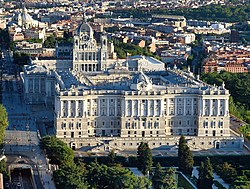
Back قصر مدريد الملكي Arabic قصر مدريد الملكى ARZ Palaciu Real de Madrid AST Кралски дворец в Мадрид Bulgarian Palau Reial de Madrid Catalan Královský palác v Madridu Czech Palacio Real (Madrid) Danish Palacio Real (Madrid) German Βασιλικό Ανάκτορο της Μαδρίτης Greek Reĝa Palaco de Madrido Esperanto
| Royal Palace of Madrid | |
|---|---|
Palacio Real de Madrid (Spanish) | |
 Aerial view | |
 | |
| General information | |
| Architectural style | Baroque, Classicism |
| Town or city | Madrid |
| Country | Spain |
| Coordinates | 40°25′05″N 03°42′51″W / 40.41806°N 3.71417°W |
| Construction started | 7 April 1735 |
| Client | King Philip V of Spain |
| Technical details | |
| Floor area | 135,000 m2 (1,450,000 sq ft) |
| Design and construction | |
| Architect(s) | Filippo Juvarra (first of many) |
| Official name | Palacio Real de Madrid |
| Type | Non-movable |
| Criteria | Monument |
| Designated | 1931 |
| Reference no. | RI-51-0001061 |
The Royal Palace of Madrid (Spanish: Palacio Real de Madrid) is the official residence of the Spanish royal family at the city of Madrid, although now used only for state ceremonies. The palace has 135,000 m2 (1,450,000 sq ft) of floor space and contains 3,418 rooms.[1][2] It is the largest royal palace in Europe.[3]
The palace is owned by the Spanish state and administered by the Patrimonio Nacional, a public agency of the Ministry of the Presidency.[4] The palace is on Calle de Bailén ("Bailén Street") in the western part of downtown Madrid, east of the Manzanares River, and is accessible from the Ópera metro station. Felipe VI and the royal family do not reside in the palace, choosing instead the Palace of Zarzuela in El Pardo.

The palace is on the site of a bygone Muslim-era fortress constructed by Emir Muhammad I of Córdoba in the 9th century.[5] The imposing Alcázar of Madrid provided both a safe for the royal treasure and a habitual residence to the Trastámara monarchs in the late Middle Ages.[6] Having endured substantial expansion works during the 16th century, the royal alcázar remained on the site until it burned down on 24 December 1734. A new palace was then built from scratch on the same site on behalf of the Bourbon dynasty. Construction spanned the years 1738 to 1755[7] and followed a Berniniesque design by Filippo Juvarra and Giovanni Battista Sacchetti in cooperation with Ventura Rodríguez, Francesco Sabatini, and Martín Sarmiento. During the Second Spanish Republic the building was known as "Palacio Nacional".
The interior of the palace is notable for its wealth of art and the use of many types of fine materials in the construction and the decoration of its rooms. It includes paintings by artists such as Caravaggio, Juan de Flandes, Francisco de Goya, and Diego Velázquez, and frescoes by Giovanni Battista Tiepolo, Corrado Giaquinto, and Anton Raphael Mengs. Many of the paintings at some time hung in the palace as part of the Spanish royal collection are exhibited elsewhere, especially in the Prado Museum and the Royal Collections Gallery, both in Madrid.
Other collections of great historical and artistic importance preserved in the building include the Royal Armoury of Madrid, porcelain, watches, furniture, silverware, and the world's only complete Stradivarius string quintet.
- ^ "Palacio Real". Cyberspain.com. Retrieved 30 November 2012.
- ^ "What is the biggest palace in Europe?". Ask Yahoo!. Yahoo! Inc. 28 April 2004. Archived from the original on 8 June 2011. Retrieved 29 July 2011.
- ^ Petr H. (2017). "25 Largest Palaces In The World". List 25. p. 4. Retrieved 23 June 2019.
- ^ Sancho 2014, p. 7.
- ^ Viso 2014, p. 7.
- ^ Rábade Obradó, María del Pilar (2009). "Escenario para una Corte real: Madrid en tiempos de Enrique IV". E-Spania (8). doi:10.4000/e-spania.18883. ISSN 1951-6169.
- ^ "Palacio Real de Madrid". Patrimonio Nacional (in Spanish). Archived from the original on 12 January 2013. Retrieved 23 June 2019.